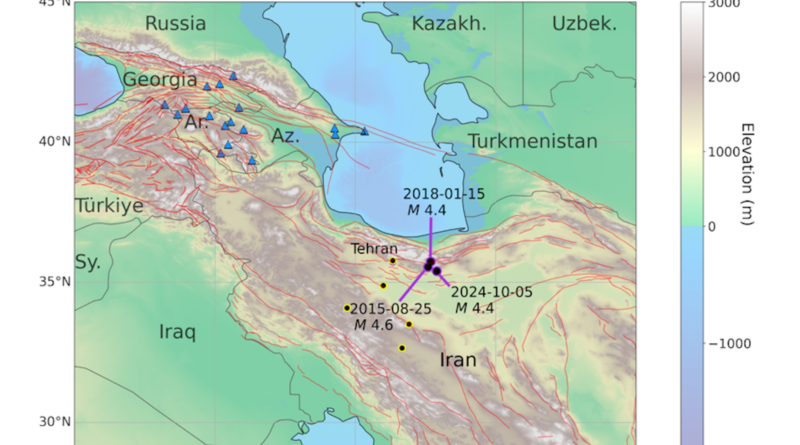Scientists Debunk Claim That Iran’s 2024 Earthquake Was a Nuclear Weapons Test
On October 5, 2024, Iran was struck by an earthquake. Just minutes later, rumors began to spread on social media that it hadn’t been a natural event, but a secret Iranian nuclear weapons test.
Now, researchers led by Johns Hopkins University have debunked these claims in a study published on February 3 in the journal Seismica. Their work reaffirms that the quake was a normal seismic event while highlighting the risk of weaponized scientific misinformation during periods of geopolitical tension.
“There was a concerted misinformation and disinformation campaign around this event that promoted the idea this was a nuclear test, which is not something you often see happen with an earthquake,” Benjamin Fernando of Johns Hopkins University, who led the study, said in a university statement. “This shows how geophysical data played an important role in a geopolitical crisis.”
Less than a year after Hamas’ attack on Israel, a magnitude 4.5 earthquake (the Comprehensive Nuclear-Test-Ban Treaty Organization reported a magnitude of 4.2) struck roughly 31 miles (50 kilometers) southwest of the Iranian city of Semnan, and 135 miles (216 km) east of the capital, Tehran.
Months later, Fernando and his colleagues analyzed the event using publicly available data from seismic monitoring stations. Seismologists study earthquakes by recording their seismic waves from different points around the planet. They concluded that “the source [of the earthquake] was what we call a reverse fault—a motion associated with the Earth’s crust being crushed as the Arabian and Eurasian plates collide,” Fernando explained. They categorically ruled out any association between the event and a secret nuclear test. “Nuclear tests have very different signatures, which are explosive,” Fernando added.
Additionally, the Comprehensive Test Ban Treaty Organization (CTBTO), which tracks nuclear tests around the globe, confirmed that similar earthquakes had occurred in the region in 2015 and 2018. Because of its location between the converging Arabian and Eurasian tectonic plates, Iran is known to be a seismically active region.
Nevertheless, rumors that the seismic activity was not natural quickly spread on social media. According to the study, the first such post appeared on X less than 20 minutes after the trembler—a comment claiming that the shaking was caused by an Israeli strike on Iran. The first suggestion that a nuclear test caused the earthquake appeared 27 minutes after the shaking. From there the misinformation spiraled, highlighting incorrect interpretations of seismic data and attracting conspiracy theories, as well as what the authors identified as active disinformation.
Iran has gone nuclear since last night.
They used the test bombs 10 km below the surface near Semnan to ensure minimum radiation exposure and it resulted in a 4.6 scale earthquake which was recorded by seismographs.#iran #khamenai #nuclear #israel pic.twitter.com/bssDFYwdQ5— akhilesh kumar (@akumar92) October 6, 2024
Iran’s nuclear program has been at the center of tensions in the Middle East for decades, with Iran maintaining it has peaceful intentions while the U.S. and its allies work to prevent it from developing nuclear weapons. Allegations of secretive nuclear weapons tests could potentially push the region—and the world—to the brink of war.
The challenge in identifying active disinformation lies in distinguishing strategic misinformation from simple ignorance. However, a “pattern of substantial and sustained engagement with other users, and a knowledge of seismology,” seen within certain social media interactions “does potentially imply a human author with some specialist knowledge of this material,” the researchers explained in the study, suggesting an intentional effort to mislead.
As the scientists pointed out in the new study, newspapers around the world quickly picked up on the frenzy, including outlets in the U.S., France, the U.K., Israel, India, Pakistan, and Zimbabwe. Mainstream English-language media outlets “almost exclusively speculated (or otherwise entertained the idea) that this event may have been a nuclear test,” the researchers wrote.
As a result, “these articles could be seen as indirectly supporting the propagation of misinformation by giving credence and visibility to misinformed interpretations of complex seismic data and by failing to seek independent, expert verification.” On the other hand—and perhaps unsurprisingly—the researchers found that Persian-language media generally reported the event more accurately, frequently relying on local experts.
The researchers ultimately provided suggestions for how the scientific community can potentially prevent such widespread misinformation in the future.
“Scientific agencies could issue detailed reports swiftly to counter misinformation,” suggested Saman Karimi of Johns Hopkins University, a co-author of the study. “Giving amplification to contents coming from verified scientific accounts could help reduce the misleading narrative. This can be done via partnership between social media platforms and trusted seismologists or agencies such as the U.S. Geological Survey.”
Ultimately, the study highlights how scientific misinformation could have dire global consequences.

